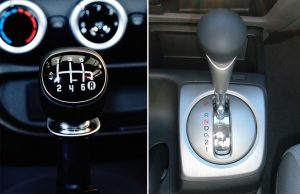 One of the first decisions that drivers need to make when they buy new cars is whether to buy one with an automatic transmission or a manual transmission. This can be a difficult choice, but it doesn’t have to be. Read on to find out about five of the pros and cons of each to make a careful, informed decision.
One of the first decisions that drivers need to make when they buy new cars is whether to buy one with an automatic transmission or a manual transmission. This can be a difficult choice, but it doesn’t have to be. Read on to find out about five of the pros and cons of each to make a careful, informed decision.
Pros of Automatic Transmissions
- Automatic vehicles are easier to drive, especially for those who have never learned how to drive manual. The car does all the shifting for its driver, so there’s no need to worry about pushing down the clutch.
- There’s next to no risk of stalling in an automatic vehicle, which can avoid a lot of awkward situations. The only time an automatic transmission will stall is if the vehicle has an underlying mechanical problem, in which case mechanics suggest that you bring in your car for work immediately.
- Many drivers find that automatic vehicles are more comfortable to drive since they only have two pedals. This makes for a more relaxing, enjoyable drive.
- Automatic vehicles are easier to drive in hilly areas. This is especially true when drivers are starting from a complete stop.
- Drivers who choose automatic transmissions can keep both their hands on the steering wheel. This is much safer for new drivers.
Cons of Automatic Transmissions
- Automatic vehicles cost more. They require a higher upfront investment and more maintenance due to the complexities of their transmission systems.
- Vehicles with automatic transmissions are also less fuel-efficient than their manual counterparts. Since they rely on torque converters to switch gears, they won’t always be in the best gear for economizing fuel.
- Drivers behind the wheels of automatic vehicles have less control over their cars. Many drivers don’t like that their transmissions choose when to shift for them.
- Thieves are more likely to steal automatic vehicles. Since they’re easier to drive, they’re also easier targets.
- Automatic transmissions are more likely to break down. They require more preventative maintenance because they’re more complex.
Pros of Manual Transmissions
- Driving a stick shift gives drivers more control. They’re able to shift through the gears to slow down and speed up more naturally.
- Manual transmissions don’t need as much maintenance since they have a simpler design. Note that the clutch may eventually need to be replaced, though.
- Manual vehicles are more fuel-efficient. They use less power than automatic cars.
- A vehicle with a standard transmission will usually cost less than one with an automatic transmission.
Plus, it will cost less to maintain.
Manual vehicles are less likely to be stolen. Not only are they more difficult to drive for those who don’t have enough experience, but they’re also less popular. These factors make them less of a target.
Cons of Manual Transmissions
- Drivers can’t keep both their hands on the wheel. This can feel unsafe for some.
- Manual clutches are operated with the left foot. Some drivers don’t like having to use both hands and both feet to get from A to B.
- It takes time to learn to drive stick. Manual transmission vehicles don’t usually make good first cars.
- Drivers sometimes have a hard time reselling their manual vehicles. This is largely due to their lower popularity.
- Manual vehicles are difficult to drive in cities. They’re also harder to drive up and downhills.
The Bottom Line

As a general rule, first-time buyers usually prefer automatic cars. Experienced drivers who want more control like manual transmissions. Ultimately, it’s a matter of preference. Normally a muscle car will have a manual transmission. Make sure to choose wisely.










